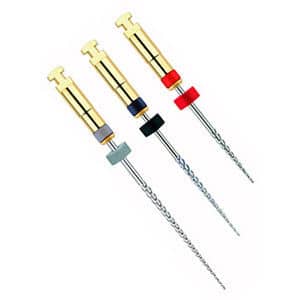
Restorative Dentistry
Unlike cosmetic dentistry which focuses on improving the appearance of your teeth, restorative dentistry primarily focuses on preserving your natural teeth. It includes treatments such as dental implants, dental crowns, fillings and root canal therapy. The latter is often used to save teeth with inflamed pulp from extraction, allowing them to remain functional for several years.
Root canal treatment, endodontics
Root canal therapy is one of the most common restorative dental procedures. Its primary goal is to remove inflamed or necrotic tissue from inside the tooth, preventing further damage and eliminating pain.
Endodontics is the field of dentistry focused on root canal treatments which, although being part of general dentistry, is becoming a specialized field due to advancements in technology (rotary instruments, apex locators and specialized microscopes) and an increasing demand for these services.


Why is root canal treatment necessary?
Many people fear root canal treatment, even though its main purpose is to preserve the natural tooth. The procedure is performed on teeth where decay-causing bacteria have reached the pulp chamber, which contains the tooth’s blood vessels and nerves. Without treatment, these teeth become sources of infection and are ultimately destined for extraction. The essence of root canal therapy is to clean the root canals thoroughly and seal them tightly. Once the root is no longer inflamed, the tooth can be restored and remain functional and pain-free for many years.
Cleaning and disinfecting the canals is typically a routine procedure for experienced endodontists. However, extremely narrow or curved canals can present significant challenges. Fortunately, modern tools such as ultra-thin, flexible nickel-titanium alloy files enable effective treatment even in these cases. Microscopes designed specifically for root canal therapy, offering 15-20x magnification, are particularly useful. They assist in locating all canals and replacing any inadequate previous root fillings.
Root canal treatment is often performed following severe tooth pain, providing patients with substantial relief while preserving the tooth in most cases. Although some sensitivity or discomfort may occur between treatments or even after the final root filling, these symptoms usually resolve quickly.
The root canal treatment process
Root canal treatment follows a series of typical steps, although specific cases may vary. This general overview provides insight into what to expect during the procedure.
- The first step is diagnosis which often requires an X-ray, even though the symptoms are typical in most cases. If the pain persists even after taking painkillers, root canal treatment is usually necessary.
- The procedure begins with anaesthesia. Although many patients find the injection uncomfortable, the endodontist often points out that this is the most unpleasant part of the treatment. After the injection, the patient won’t experience any pain.
- Next, a hole is drilled into the crown of the tooth to access the pulp chamber.
- Once the pulp chamber is exposed, the dentist thoroughly examines the inside of the tooth and identifies the root canals.
- The next step is cleaning the canals with various instruments. The aim is to remove the tissue causing the inflammation as well as the outer layer of the root canal, ensuring that only healthy tissue remains in the tooth canal.
- After the canals have been cleaned, a disinfectant is injected in the canal to completely eliminate the inflammation.
- The dentist places a temporary filling in the crown of the tooth.
- This is typically followed by a one-week break. If no issues arise during this time, the dentist will insert the permanent root filling after one week, completing the procedure. If the patient experiences sensitivity or pain, the root canal needs to be flushed and disinfected with a different disinfectant. This is followed by another week of observation; the cycle repeats until the inflammation is completely resolved.
Dental fillings
When it comes to tooth fillings, restoring chewing function is not the only priority. Ensuring that the patient is satisfied and sees their teeth as healthy again is equally important. Tooth-colored fillings can serve an aesthetic dental solution for replacing lost tooth material.
The goal of filling is not only to restore chewing function and correct any speech impairment; the result must also meet aesthetic requirements. During the filling process, we prioritize the preservation of as much healthy tooth tissue as possible, which is achieved via using the so-called adhesive filling technique.
After the conditioning gel is removed, the bonding resin is applied and cured using a LED light. The conditioning and bonding process allows the filling to achieve micro-retentive adhesion to the tooth structure. This means that no healthy tooth tissue needs to be removed unnecessarily, unlike with older methods such as amalgam fillings.
The tooth-colored filling is applied layer by layer, with each layer being individually cured. In the final phase of the filling process, the edges of the filling are smoothed, and the contact with the opposing tooth is checked. The filling is then completed with a high-gloss polish.
We use the most advanced materials available for tooth-colored fillings.
Gyökérkezelések
Klinikánkon a korrekt orvosszakmai ellátás érdekében a kis- és nagyőrlő fogak gyökérkezelését csak mikroszkópos módszerrel, erre specializálódott kollégák végzik.
Gyökérkezelés: trepanálás (1-2 csatorna)
A trepanálás a gyökérkezelés egyik első fázisa, amely során a fogorvos megnyitja az idegkamrát és megkeresi a gyökércsatornákat. Ez a tevékenység a fogászatban rutinmunkának számít, de nagy szakértelmet és körültekintést igényel, mivel a fogak gyökércsatornái sokszor igen vékonyak és bonyolult rendszerűek.
40 000 Ft - 55 000 Ft
Gyökérkezelés: tágítás (1-2 csatorna)
A gyökérkezelés második fázisában a fogorvos feltágítja és kitisztítja a gyökércsatornákat, előkészítve a fogászati kezelés következő fázisát, melynek során egy ideiglenes tömés kerül a gyökércsatornákba.
40 000 Ft - 55 000 Ft
Gyökértömés (1-2 csatorna)
A gyökértömés során először csak egy ideiglenes, gyógyszeres tömés kerül a fogba. Ha a páciens panaszmentes, a szakember előkészíti a következő fázist: néhány nap után végleges tömés kerül a fogba.
40 000 Ft - 55 000 Ft
Trepanálás akut páciens esetén
40 000 Ft
Trepanálás akut páciens esetén koronán vagy hídon keresztül
55 000 Ft
Ideiglenes gyógyszeres lezárás
18 500 Ft
Fogtömés
A fogak tömésénél sokszor nem csak a rágási funkció helyreállítása a fontos, hanem az is, hogy a páciens újra jól érezze magát, egészségesnek lássa a fogsorát. A fogszínű tömés egy esztétikus fogászati megoldás a hiányos foganyag pótlására.
Esztétikus Fogtömés
A fogszínű tömés jó megoldás azok számára, akiknek az egészségük mellett a megjelenés is fontos.


